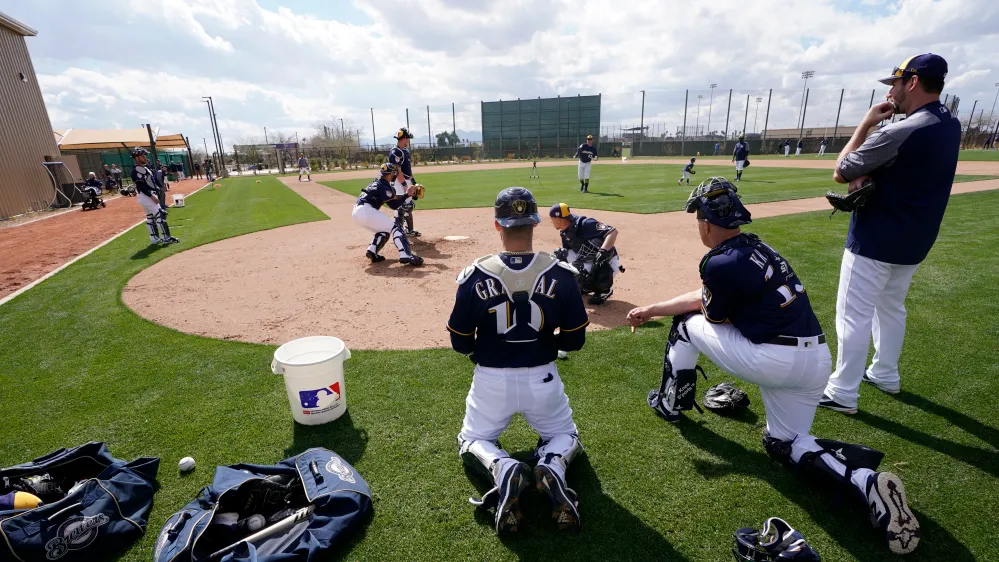When watching an MLB game, the casual fan notices the basics. They see the players on the field, the batter stepping into the box, and the guys in the dugout, chewing gum or whatever other stimulants keep them locked in.
The trained baseball eye picks up on more. They scan the bullpen to see who’s warming up, track stats beyond what’s on the scoreboard, and watch the outfielders in the game’s many idle moments.
But what almost no one notices is the man in catcher’s gear, warming up the league’s best arms with no intention of playing. The do-it-all figure who keeps the team running before and during the game. He’s throwing batting practice, rubbing down baseballs in the tunnels beneath the stadium, doing whatever needs to be done. He won’t play. For some, he won’t even be listed on the roster. The lack of recognition these quiet contributors get is frankly a tragedy.
Raise a glass for the bullpen catchers—baseball’s unsung heroes.
Generally unknown to baseball fans, but widely respected in every clubhouse for the work they do. Specifically with pitchers, who in crucial moments need to activate their arms at a moment’s notice.
“They help us build confidence quickly,” A’s reliever Tyler Ferguson said. “Help us find that groove as quickly as possible. Sometimes you don’t have much time down there (in the bullpen to warm up), so they’re great. They’re the backbone of the bullpen.”
If you were to ask a bullpen catcher, like the A’s Dustin Hughes, what their role is, you’d first hear exactly what you expect. They help the pitchers warm up in the bullpen, whether it’s playing catch or anything else. However, if you stopped to really listen and care, you’d hear their roles stretch beyond just their gloves.
“We take care of all the pitchers, Hughes said. “We make sure that everything is taken care of. We also facilitate the coaches. We’re kind of the coach’s assistant, and make sure anything that they need is out on the field and make the job easy.”
The responsibilities on gameday (162 of them) are non-stop and their work facilitates the success the fans get to watch. Except they would have already put a whole day of labor in before any fan stepped through turnstiles.
We’re the ones that set up all the machines on the field and make sure all the baseballs and everything that the coaches need is out there,” Hughes said. “We set up about four machines, set up the cages, and make sure all the balls are in there. We set up the fields for pitchers to throw. It just keeps on going and going, making sure that the
stadium is set up for batting practice, and if there are any last-minute changes that the coaches need us to change.”
The bullpen catcher is part safety net, part problem solver, part human fix-it machine keeping the pitching staff in rhythm. One minute, they’re tossing balls to the world’s most powerful bats; the next, they’re making sure a reliever’s warm-up routine doesn’t veer off course. They’re silent operators in a sport that thrives on superstition, routine, and preparation.
The role continues to evolve. Teams have begun deploying bullpen catchers for more than just warm-ups or stadium operations. They’re tracking analytics, assisting the coaching staff, and handling whatever else is needed. The job description has expanded in recent years, but the core responsibility remains unchanged: be ready for anything, help with everything.
“Nowadays, you’re starting to see teams shift to using them for all sorts of things,” former Colorado Rockies bullpen catcher Aaron Muñoz said. “Whether it’s for the analytics side of things or to help out with certain other areas. You show up, and you’re ready for everything, You’ve got to set up baseballs, make sure the pitchers are ready to go, and know their routines to help them prep for the game. Then once the game starts, you’re ready to help.”
This isn’t to say that every baseball fan—casual or seasoned—should memorize every bullpen catcher in the league, as they do every ace pitcher.
Even though they definitely should.
This is to say that it’s important for even the occasional viewer to recognize that every time they see Yankees outfielder Aaron Judge approach the plate, ready to send a baseball into orbit, or Pirates pitcher Paul Skenes step up to the mound, they should know that a bullpen catcher had something to do with getting those players ready to be in that moment. They may not notice just by looking around come first pitch, but baseball’s unsung heroes are ever-present, affecting the game every day.


